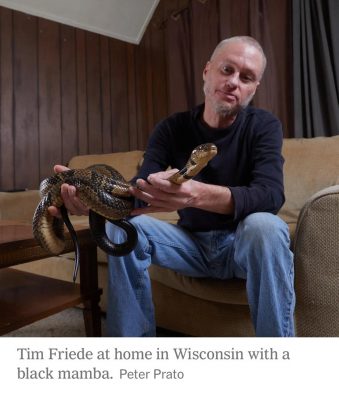Over nearly 18 years, an American , Tim Friede, 57, injected himself with carefully calibrated, escalating doses of venom to build his immunity to 16 deadly snake species.
According to New York Times the man also allowed the snakes — mostly one at a time, but sometimes two, as in the video — to sink their sharp fangs into him about 200 times.
Now scientists say his blood may hold answer for millions around the world bitten by snakes yearly.
More than 600 species of venomous snakes roam the earth, biting as many as 2.7 million people, killing about 120,000 people and maiming 400,000 others — numbers thought to be vast underestimates.
Scientists said Friday in their report on n a journal they have identified antibodies in Mr Friede’s blood that are capable of neutralizing the venom of multiple snake species, a step toward creating a universal antivenom.
“I’m really proud that I can do something in life for humanity, to make a difference for people that are 8,000 miles away, that I’m never going to meet, never going to talk to, never going to see, probably,” said Mr. Friede, who lives in Two Rivers, Wisconsin, where venomous snakes are not much of a threat.
While deforestation, human sprawl and climate change have heightened the danger from snake attacks in recent years, research on antivenom has not kept pace with demand.
“This is a bigger problem than the first world realizes,” said Jacob Glanville, founder and chief executive of Centivax, a company that aims to produce broad-spectrum vaccines, and lead author on the study.
Dr. Glanville and his colleagues found that two powerful antibodies from Mr. Freide’s blood, when combined with a drug that blocks neurotoxins, protected mice from the venom of 19 deadly snake species of a large family found in different geographical regions.
This is an extraordinary feat, according to experts not involved in the work. Most antivenoms can counter the venom from just one or a few related snake species from one region.
The study suggests that cocktails of antitoxins may successfully prevent deaths and injuries from all snake families, said Nicholas Casewell, a researcher at the Liverpool School of Tropical Medicine in England.
“The principles of this study can definitely be applied to other snakes,” he said.
Mr. Friede’s first snake encounter, a harmless bite by a garter snake at age 5, started a lifelong fascination. “If I only knew back then what was going to happen,” he recalled, laughing uproariously.
But he didn’t begin dabbling with snakes in earnest until he was married with children and working in construction. He began experimenting with scorpions around the year 2000, but quickly switched to snakes. At one point, his basement lab housed 60 venomous snakes.
His experiments nearly ended soon after they began. On Sept. 12, 2001, crazed by the terrorist attack of the previous day and by the death of a friend a few days earlier, he let himself be bitten by two cobras. They were his first bites by live snakes, and he had not built up enough immunity. He was fine after the first bite, but after the second, he felt cold, his eyes started to droop and he couldn’t talk. He blacked out and woke up from a coma in a hospital four days later.
His wife was furious, but he was angrier with himself. He vowed to become more methodical in his work, carefully measuring out doses of venom and timing his bites.
“I’d work all day, come home, play with the kids and the family, and go downstairs and do my stuff all night long, wake up and do it again,” he said.
There were other mishaps — accidental bites, anaphylactic shocks, hives, blackouts. Mr. Friede describes himself as a nondegree scientist, but “there’s no college in the world that can teach you how to do it,” he said. “I was doing it on my own as best I could.”
Two teams of scientists sampled Mr. Friede’s blood over the years, but neither project led anywhere. By the time he met Dr. Glanville, in 2017, he was nearly ready to give up.
Dr. Glanville had been pursuing what scientists call broadly acting antibodies as the basis for universal vaccines against viruses. He grew up in a Maya village in the Guatemala highlands, and became intrigued by the possibility of using the same approach for universal antivenom.
At first, he said, he had a “humble” goal of finding someone like a clumsy snake researcher who had been bitten a couple of times. But then he came across news articles about Mr. Friede.
“I’ve been waiting for this call for a long time,” Dr. Glanville recalls Mr. Friede as saying.






